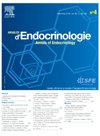暴露于人类母乳中内分泌干扰化合物混合物对行为和神经发育影响的综合研究
IF 2.9
3区 医学
Q3 ENDOCRINOLOGY & METABOLISM
引用次数: 0
摘要
人类通过环境污染暴露于各种化学物质,随后受到物质的异质混合物的污染。然而,人类健康风险评估仍然是在逐种物质的基础上进行的。材料和方法在此背景下,该团队为评估异质污染物混合物的化学风险的新方法的发展做出了贡献。这种方法被应用于法国ContaLait调查,该调查测量了母乳中的几种污染物。对综合风险的初步理论评估表明,包括运动和认知功能在内的神经发育过程存在高风险。因此,我们的研究旨在产生实验数据,通过表征这种人类母乳污染物混合物对运动和认知过程的影响来建立和改进这种方法。8周大的C57BL6/J雌性小鼠口服暴露于含有理论方法确定的5种“驱动因素”(PCB153、DDE、2,3,7,8- tcdd、狄氏剂、砷)的母乳污染物混合物中,剂量为估计的环境剂量,浓度为10倍和25倍。暴露在交配前两周进行,然后在妊娠和哺乳期进行。结果和讨论我们的初步结果表明,无论剂量是多少,这种混合物对母鼠体重、产仔数或幼崽存活率都没有影响。在雄性和雌性后代的身体生长、发育标志物(如皮毛生长、睁眼和青春期年龄)上观察到剂量依赖性的治疗效果。结论和局限性最后,正在进行分析,以确定暴露于不同剂量的人类母乳混合物对成年男性和女性后代的运动,焦虑以及时间和空间记忆的影响。本文章由计算机程序翻译,如有差异,请以英文原文为准。
An integrative study on behavioral and neurodevelopmental effects of exposure to human breastmilk mixture of endocrine disrupting compounds
Introduction
Human populations are exposed to a variety of chemical substances through environmental pollution, ensuing in contamination by heterogeneous mixtures of substances. However, human health risk assessment is still carried out on a substance-by-substance basis.
Materials and methods
In this context, the team has contributed to the development of a new methodological approach for assessing the chemical risk of heterogeneous contaminants mixtures. This methodology was applied to the French ContaLait survey, which measured several contaminants in breast milk. This initial theoretical assessment of combined risks suggests a high risk for neurodevelopmental processes including motor and cognitive functions. Thus, our study aims to generate experimental data to establish and improve this methodology by characterizing the effects of this human breast milk contaminants mixture on motor and cognitive processes. Eight-week-old C57BL6/J females were orally exposed to a mixture of breast milk contaminants containing the 5 “drivers” identified by the theoretical approach (PCB153, DDE, 2,3,7,8-TCDD, dieldrin, arsenic) at the estimated environmental dose and at doses 10 and 25 times more concentrated. Exposure was carried out two weeks before mating, then during gestation and lactation.
Results and discussion
Our initial results show that, whatever the dose, the mixture has no effect on maternal weight, litter size or pup survival. A dose-dependant treatment effect was observed on body growth, developmental markers such as fur growth, eye opening and age at puberty in male and female offspring.
Conclusion and limitations
Finally, analyses are underway to determine the effects of exposure to human breast milk mix at different doses on locomotion, anxiety, as well as temporal and spatial memory in adult male and female offspring.
求助全文
通过发布文献求助,成功后即可免费获取论文全文。
去求助
来源期刊

Annales d'endocrinologie
医学-内分泌学与代谢
CiteScore
4.40
自引率
6.50%
发文量
311
审稿时长
50 days
期刊介绍:
The Annales d''Endocrinologie, mouthpiece of the French Society of Endocrinology (SFE), publishes reviews, articles and case reports coming from clinical, therapeutic and fundamental research in endocrinology and metabolic diseases. Every year, it carries a position paper by a work-group of French-language endocrinologists, on an endocrine pathology chosen by the Society''s Scientific Committee. The journal is also the organ of the Society''s annual Congress, publishing a summary of the symposia, presentations and posters. "Les Must de l''Endocrinologie" is a special booklet brought out for the Congress, with summary articles that are always very well received. And finally, we publish the high-level instructional courses delivered during the Henri-Pierre Klotz International Endocrinology Days. The Annales is a window on the world, keeping alert clinicians up to date on what is going on in diagnosis and treatment in all the areas of our specialty.
 求助内容:
求助内容: 应助结果提醒方式:
应助结果提醒方式:


